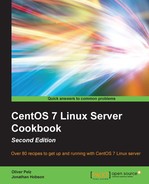- CentOS 7 Linux Server Cookbook Second Edition
- Table of Contents
- CentOS 7 Linux Server Cookbook Second Edition
- Credits
- About the Authors
- About the Reviewer
- www.PacktPub.com
- Preface
- 1. Installing CentOS
- Introduction
- Downloading CentOS and confirming the checksum on Windows or OS X
- Creating USB installation media on Windows or OS X
- Performing an installation of CentOS using the graphical installer
- Running a netinstall over HTTP
- Installing CentOS 7 using a kickstart file
- Getting started and customising the boot loader
- Troubleshooting the system in rescue mode
- Updating the installation and enhancing the minimal install with additional administration and development tools
- 2. Configuring the System
- Introduction
- Navigating text files with less
- Introduction to Vim
- Speaking the right language
- Synchronizing the system clock with NTP and the chrony suite
- Setting your hostname and resolving the network
- Building a static network connection
- Becoming a superuser
- Customizing your system banners and messages
- Priming the kernel
- 3. Managing the System
- Introduction
- Knowing and managing your background services
- Troubleshooting background services
- Tracking system resources with journald
- Configuring journald to make it persistent
- Managing users and their groups
- Scheduling tasks with cron
- Synchronizing files and doing more with rsync
- Maintaining backups and taking snapshots
- Monitoring important server infrastructure
- Taking control with GIT and Subversion
- 4. Managing Packages with YUM
- 5. Administering the Filesystem
- 6. Providing Security
- 7. Building a Network
- 8. Working with FTP
- 9. Working with Domains
- 10. Working with Databases
- 11. Providing Mail Services
- 12. Providing Web Services
- 13. Operating System-Level Virtualization
- 14. Working with SELinux
- 15. Monitoring IT Infrastructure
- Index
In this book, you will find a number of text styles that distinguish between different kinds of information. Here are some examples of these styles and an explanation of their meaning.
Code words in text, database table names, folder names, filenames, file extensions, pathnames, dummy URLs, user input, and Twitter handles are shown as follows: "For the purpose of this recipe, it is assumed that all the downloads will be stored on Windows in your personal C:Users<username>Downloads folder, or if using an OS X system, in the /Users/<username>/Downloads folder."
A block of code is set as follows:
<?xml version="1.0" encoding="utf-8"?> <service> <description>enable FTPS ports</description> <port protocol="tcp" port="40000-40100"/> <port protocol="tcp" port="21"/> <module name="nf_conntrack_ftp"/> </service>
Any command-line input or output is written as follows:
sudo diskutil unmountDisk /dev/disk3 sudo dd if=./CentOS-7-x86_64-Minimal-XXXX.iso of=/dev/disk3 bs=1M
New terms and important words are shown in bold. Words that you see on the screen, for example, in menus or dialog boxes, appear in the text like this: "Clicking the Next button moves you to the next screen."
-
No Comment
